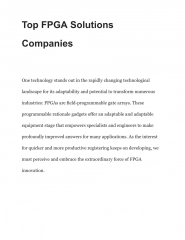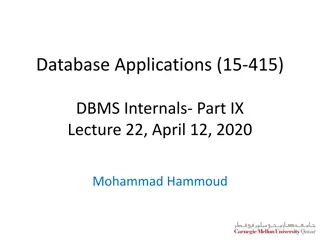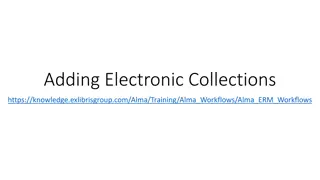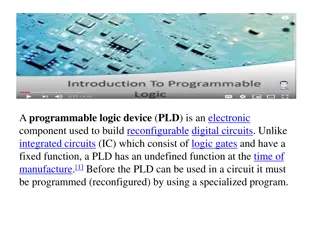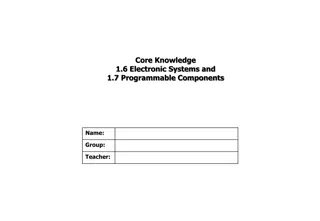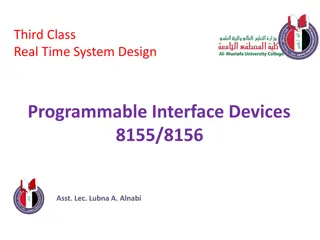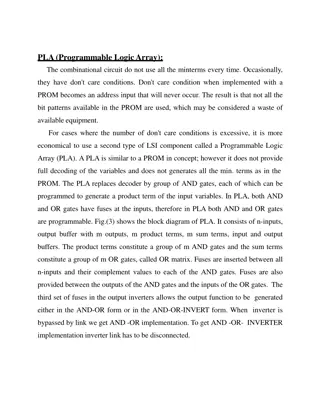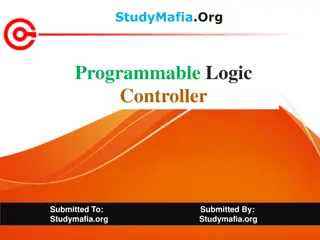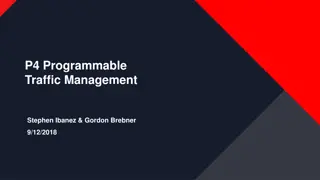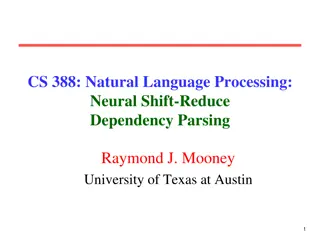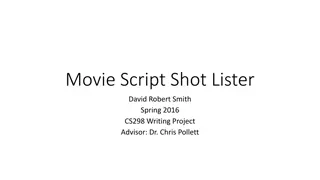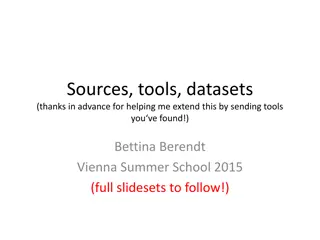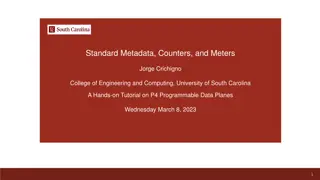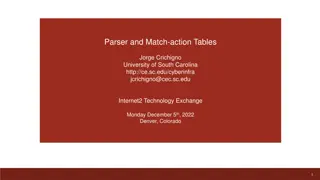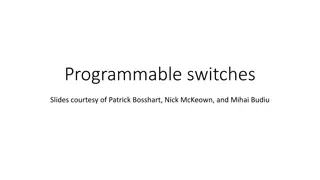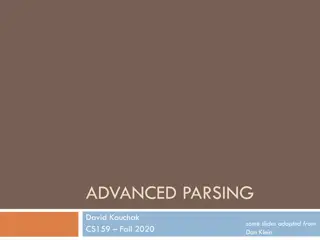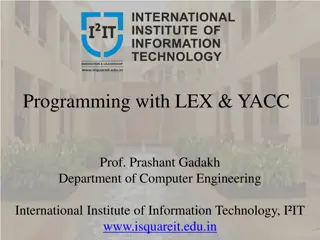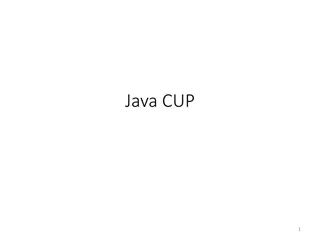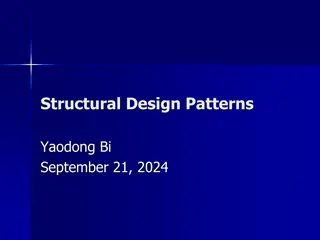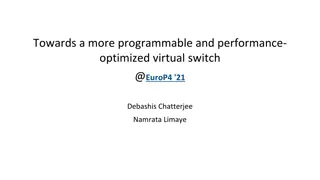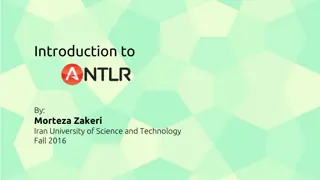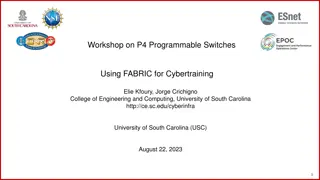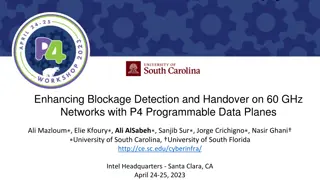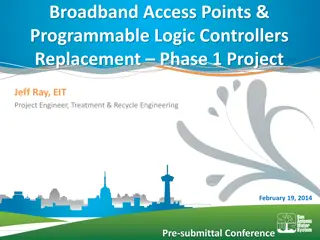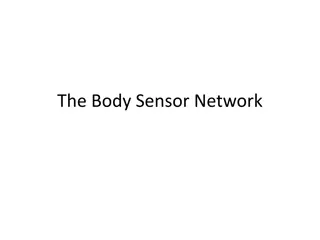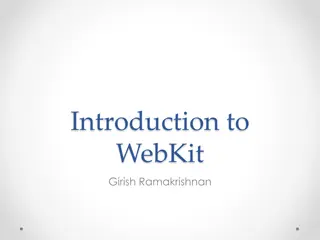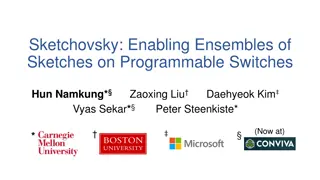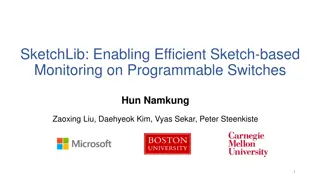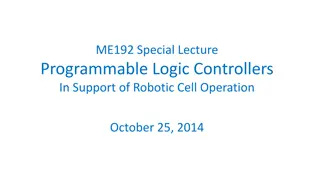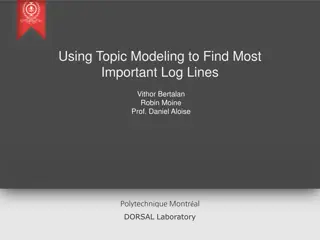Top FPGA Solutions Companies
In the rapidly evolving technological landscape, one technology stands out for its versatility and potential to revolutionize various industries: Field-Programmable Gate Arrays (FPGAs). These programmable logic devices offer a flexible and customizable hardware platform that enables engineers and de
1 views • 1 slides
Tinkering with Sphero Indi
Dive into a bite-sized Tech Tuesday lesson where you'll learn to tinker with Sphero Indi, a programmable robot. Discover the basics of robotics, directional commands, and sequencing paths. Engage in activities like predicting Indi's movements and creating your own paths. Explore cross-curricular app
0 views • 13 slides
Understanding Computer Hardware and Software Fundamentals
A computer is a programmable electronic device consisting of hardware and software that enables input, processing, storage, and output of information. This includes characteristics, basic components, application software, and advanced processing stages like ALU, input/output devices, control unit, R
0 views • 14 slides
Hands-On Training with P4 and Hardware Switches at University of South Carolina
The University of South Carolina offers hands-on training using hardware switches in a cloud system. The system provides remote-access capability to lab equipment for virtual labs on P4, routing, high-speed networks, and cybersecurity. Open-source libraries consist of various activities and experime
0 views • 11 slides
Virtual Labs on SDN and P4 Programmable Switches
Explore the motivation behind Software-Defined Networking (SDN) and P4 programmable switches, highlighting the shift from traditional networking to more flexible and innovative approaches. Understand how SDN challenges protocol ossification, separates control and data planes, and enables packet-forw
2 views • 47 slides
Query Optimization in Database Management Systems
This content covers the fundamentals of query optimization in Database Management Systems (DBMS), including steps involved, required information for evaluating queries, cost-based query sub-system, and the role of various components like query parser, optimizer, plan generator, and cost estimator. I
0 views • 51 slides
Efficient Workflow for Adding Electronic Collections in Alma
Detailed guidance on ordering, activating, and managing electronic collections in Alma's ERM module. Learn about roles, purchase types, resources, CDI functionality, link resolver, parser parameters, and more. Understand the importance of portfolios and services in providing access to electronic res
0 views • 25 slides
Understanding Programmable Logic Devices (PLD) in Digital Electronics
Programmable Logic Devices (PLDs) are versatile electronic components used to create reconfigurable digital circuits, distinct from fixed-function integrated circuits. PLDs require programming before use, enabling customization for specific functions. This article explores PLDs, digital electronic s
0 views • 10 slides
Understanding Electronic Systems and Programmable Components
Dive into the world of electronic systems and programmable components by exploring key terms, sensors like Light Dependent Resistor and Thermistor, control devices, circuit components, and flow charts. Learn about inputs, outputs, feedback loops, and how to design simple routines for controlling out
1 views • 6 slides
Programmable Interface Devices 8155/8156 Overview and Design Considerations
Explore the capabilities of programmable interface devices 8155/8156 for interfacing I/O devices to microprocessors. Learn about their features, block diagrams, control signals, and address determination. Discover how to design interfacing circuits for reading data from A/D converters using the 8155
0 views • 10 slides
Understanding Programmable Logic Arrays (PLA)
Programmable Logic Arrays (PLAs) provide a flexible way to implement combinational circuits with don't care conditions efficiently. PLAs use programmable AND and OR gates to generate product terms, offering a more economical solution compared to PROMs for circuits with excessive don't care condition
0 views • 19 slides
Understanding Programmable Logic Controllers (PLC)
Programmable Logic Controllers (PLCs) are tiny computers used to control system functions with programmed logic. They receive inputs and provide operating instructions to automate processes in various industries. PLCs have replaced manual relay-based systems and are essential in industrial control t
0 views • 24 slides
Understanding Programmable Traffic Management for Network Optimization
Programmable Traffic Management involves packet scheduling, traffic shaping, policing, drop policies, packet buffering, replication, and classification to optimize network performance. It is used in integrated switch architectures and is crucial for addressing diverse traffic characteristics and req
0 views • 66 slides
Workshop on Fine-grained Measurements App with P4 Programmable Switches
Explore the world of P4 programmable switches in a workshop hosted by the University of South Carolina. Learn about P4, programmable data plane switches, packet parsing, queue monitoring, and applications with P4 switches. Discover the shift from traditional networking to SDN, overcoming limitations
1 views • 19 slides
Neural Shift-Reduce Dependency Parsing in Natural Language Processing
This content explores the concept of Shift-Reduce Dependency Parsing in the context of Natural Language Processing. It describes how a Shift-Reduce Parser incrementally builds a parse without backtracking, maintaining a buffer of input words and a stack of constructed constituents. The process invol
0 views • 34 slides
Movie Script Shot Lister Tool Development Project
This project aims to create a tool, the Lister Tool, that takes properly formatted motion picture scripts as input and generates a shot list for the movie using Training Sets and Naive Bayes. The project involves several components such as the Parser, Liner Tool, Training Sets, and more. The ultimat
2 views • 42 slides
Exploring Sources, Tools, and Datasets in Text Mining
Discover a plethora of sources, tools, and datasets in text mining through resources shared by Bettina Berendt and references from lectures and publications. Uncover DH-specific tools and powerful NLP tools like Ling Pipe, OpenNLP, Stanford Parser, and NLTK Toolkit for text analysis and processing.
0 views • 17 slides
Understanding Standard Metadata, Counters, and Meters in P4 Programmable Data Planes
Learn about the role of metadata in packet processing, the significance of intrinsic metadata, and how to utilize custom headers for monitoring switch queues in P4 programmable data planes. This tutorial explores the V1 Model standard metadata and provides hands-on experience in defining and using c
0 views • 21 slides
Programmable Parser and Header Definitions at University of South Carolina
Programmable parsers and custom header definitions play a crucial role in network packet processing. This presentation by Jorge Crichigno at the University of South Carolina covers topics such as parser operation, predefined states, and header formats. The content delves into the capabilities of pro
1 views • 22 slides
Evolution of Programmable Switches and Routers
Explore the evolution of programmable switches and routers, from early attempts at programmability to the introduction of the P4 programming language and Software Defined Networking (SDN). Discover the shift towards greater customization and control in network infrastructure, leading to the developm
0 views • 40 slides
Mathematical Operations Parser and Evaluator
This program reads a mathematical expression, tokenizes it, and evaluates it based on the order of operations. It demonstrates parsing infix to postfix notation and evaluating postfix expressions. The code contains functions for cleaning input, tokenizing expressions, and calculating results, along
0 views • 11 slides
Dynamic Semantic Parser Approach for Sequential Question Answering
Using a Dynamic Semantic Parser approach, the research focuses on Sequential Question Answering (SQA) by structuring queries based on semantic parses of tables as single-table databases. The goal is to generate structured queries for questions by defining formal query languages and actions for trans
0 views • 23 slides
Effective Fuzz Testing for Programmable Logic Controllers - Research for Nuclear Safety
This paper discusses the significance of fuzz testing for Programmable Logic Controllers (PLCs) to ensure nuclear safety, citing incidents like the Stuxnet worm attack. It delves into the methodology, zero-day vulnerability findings, and results of the research conducted by authors in February 2020,
1 views • 11 slides
Understanding Advanced Parsing Techniques for NLP Evaluation
Delve into the realm of advanced parsing with a focus on evaluating natural language processing models. Learn about tree comparison, evaluation measures like Precision and Recall, and the use of corpora like Penn Treebank for standardized parsing evaluation. Gain insights on how to assess parser per
0 views • 50 slides
Introduction to Lex and Yacc: Compiler Design Essentials
Lex and Yacc are essential tools in compiler design. Lex serves as a lexical analyzer, converting source code to tokens, while Yacc is a parser generator that implements parsing based on BNF grammars. Through these tools, strings are processed, and code is generated for efficient compilation. This i
0 views • 10 slides
Understanding Java CUP Parser Generators
Explore the world of Java CUP parser generators, focusing on creating Abstract Syntax Trees (ASTs), translating lists in context-free grammar, and the use of parser tools like YACC and Java CUP. Dive into creating grammars, token classes, and AST classes to build parsers effectively.
0 views • 15 slides
Understanding Façade Design Pattern in Structural Design Patterns
Façade design pattern simplifies the interface of a complex system by providing a unified and straightforward interface for clients to access the system's functionalities. It helps in isolating the clients from the complexities of underlying components, offering a more user-friendly experience. The
0 views • 48 slides
Towards a More Programmable and Performance-Optimized Virtual Switch @ EuroP4 '21
This presentation discusses the development of a more programmable and performance-optimized virtual switch at EuroP4 '21. It covers topics such as P4 with OVS, challenges in OVS hardware offload, P4 enhanced Open vSwitch, P4 components in OVS, stacked pipelines, and various control and data planes
0 views • 10 slides
Introduction to ANTLR: A Brief Overview
ANTLR (Another Tool For Language Recognition) is a parser generator that uses LL(*) for parsing input grammars. It generates source code in Java, C#, JavaScript, Python2, and Python3 to create language recognizers. Learn about LL(k) and LL(*) grammars, the history of ANTLR, and how it works in this
0 views • 32 slides
Workshop on P4 Programmable Switches Using FABRIC for Cybertraining - University of South Carolina
Explore the world of P4 programmable switches and FABRIC infrastructure for cybertraining at the University of South Carolina. Discover the FABRIC testbed, cybertraining opportunities, organization of labs, and hands-on labs focusing on P4 programmable data planes over FABRIC. Enhance your knowledge
0 views • 13 slides
Enhancing TCP Fairness Using P4-Programmable Data Planes
This study presents a solution to improve TCP fairness in non-programmable networks by utilizing P4-programmable data planes. It addresses unfair bandwidth distribution issues in TCP traffic and proposes a system that leverages P4 switches for passive traffic monitoring and RTT computation.
0 views • 24 slides
Enhancing Blockage Detection and Handover on 60 GHz Networks with P4 Programmable Data Planes
The study presents a system using programmable switches to monitor packet inter-arrival time for blockage detection on mmWave networks. Results show fast recovery speeds and minimal impact on flow completion time, with contributions focusing on leveraging programmable switches and real device scenar
0 views • 7 slides
Broadband Access Points & Programmable Logic Controllers Replacement Phase 1 Project Overview
This project overview provides details of the Broadband Access Points & Programmable Logic Controllers Replacement Phase 1 Project led by Jeff Ray, EIT Project Engineer at Treatment & Recycle Engineering. It includes information on the pre-submittal conference, RFQ schedule, evaluation criteria, and
0 views • 13 slides
Developing a Body Sensor Network Application for Identifying Affective Experiences and Craving for Alcohol
The project aims to develop an application that can identify affective experiences and physiological responses, particularly craving for alcohol. The application will differentiate between various mood states by collecting data which will be tested against a trained model. A system of survey schedul
0 views • 14 slides
Understanding WebKit: A Comprehensive Overview
Explore the nuances of WebKit, a powerful web content rendering engine, delving into its history, components, and capabilities. Discover how WebKit ports have made it highly portable, as well as its core elements like WebCore, JavaScriptCore, and more. Unravel the mystique behind JavaScriptCore's de
0 views • 27 slides
Sketchovsky: Enabling Sketch Ensembles on Programmable Switches
Network measurement plays a crucial role in management tasks such as port scan detection and resource provisioning. The concept of sketch ensembles on programmable switches shows promise in addressing key challenges related to control and data plane operations. This approach offers a way to efficien
2 views • 20 slides
Enhancing Efficiency in Sketch-based Monitoring for Programmable Switches
SketchLib introduces advancements in sketching algorithms to enable efficient monitoring on programmable switches. The tool bridges gaps between existing sketches for CPUs and programmable switches, offering resource optimizations and API calls to enhance performance and reduce resource consumption
0 views • 20 slides
NetLogo - Programmable Modeling Environment for Simulating Natural and Social Phenomena
NetLogo is a powerful and versatile programmable modeling environment created by Uri Wilensky in 1999. It allows users to simulate natural and social phenomena by giving instructions to multiple agents operating independently, making it ideal for modeling complex systems evolving over time. NetLogo
0 views • 7 slides
Understanding Programmable Logic Controllers (PLCs) in Robotic Cell Operations
Programmable Logic Controllers (PLCs) are versatile devices used in various industries for automation and control processes. This article explores the functionality and applications of PLCs in supporting robotic cell operations, emphasizing their role in conveyor control, multi-robot workstations, a
0 views • 15 slides
Utilizing Topic Modeling for Identifying Critical Log Lines in Research
By employing Topic Modeling, Vithor Bertalan, Robin Moine, and Prof. Daniel Aloise from Polytechnique Montréal's DORSAL Laboratory aim to extract essential log lines from a log parsing research. The process involves building a log parser, identifying important log lines and symptoms, and establishi
0 views • 18 slides
